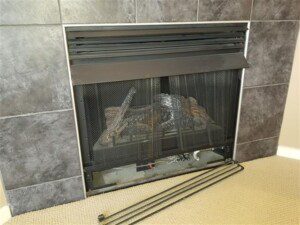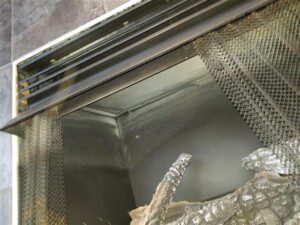
There are a few different types of gas fireplaces found in residential buildings. Older type gas fireplaces were typically originally meant to burn wood that were converted to a gas fireplace. These types of gas fireplaces have a gas line and burner installed inside the original wood fireplace. These types gas fireplaces are open to the home, and are meant to vent through an existing chimney. These open air gas fireplaces are not very efficient, and most of the heat produced from burning the gas is lost through the chimney.
Modern vented gas fireplaces are typically sealed with a glass cover, and are not open to the home. These are referred to as direct vent fireplaces. Since the combustion chamber is sealed, oxygen for combustion is provided through an opening to the exterior, and the exhaust also vents directly to the exterior. These types of fireplaces are more efficient, and can create radiant heat that can do a pretty good job of heating the room they are installed in. Direct vent fireplaces are typically vented through a metal flue pipe, either up through the roof, or through a wall in the home.

When a home has a vent-free gas fireplace, there are some possibly health and safety hazards to consider. Since the combustion gasses from a vent-free gas fireplaces vent directly into the home, it is important that the installation of the burner and other gas components are done properly. Any issues with gas pressure, or lack of proper combustion air could cause incomplete combustion, which can allow toxic gasses such as carbon monoxide to build up in the home. In addition, since water vapor is a byproduct of gas combustion, use of a vent-free gas fireplace can also allow moisture to build up in the home, which could lead to condensation and mold growth issues.
Any home with gas burning appliances should have carbon monoxide and smoke detectors installed. If you are looking to purchase a home with a vent-free gas fireplace installed, you should have the unit inspected by a licensed fireplace technician to ensure that safe conditions exist, and the unit should be serviced once per year. It is also usually a good idea to crack a window, or use exhaust devices in the home, such as a kitchen or bathroom exhaust that vents to the exterior when using a vent-free gas fireplace, and to not use the fireplace for long periods of time (usually no more than two hours).
Check out the video below about the potential dangers of a vent-free gas fireplace:
